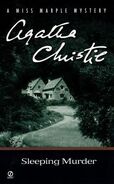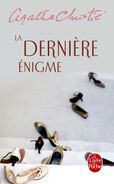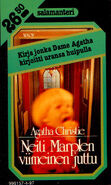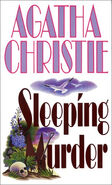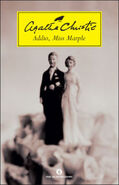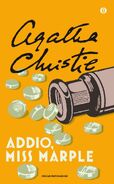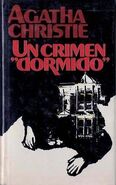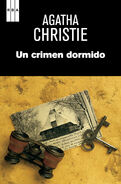Sleeping Murder: Miss Marple's Last Case is a work of detective fiction by Agatha Christie and first published in the UK by the Collins Crime Club in October 1976. In the US the book was published by Dodd, Mead and Company one month earlier in September that year.[1] The UK edition retailed for £3.50 and the US edition for $7.95. The book features Miss Marple in her last mystery. It was the last Christie novel published — posthumously — although not the last one Christie actually wrote.
Synopsis[]
A recently married twenty-one year old New Zealander Gwenda Reed (née Halliday), who believes she has never been in England before, tours Devon and buys a house which she likes in Dillmouth. After moving in, however, she has the strange feeling that she has been there before.
Plot summary[]
(may contain spoilers - click on expand to read)
"Let sleeping murder lie": this is the proverb (a variation on "Let sleeping dogs lie") which is not obeyed by twenty-one year old New Zealander Gwenda Reed (née Halliday), who has recently married and now comes to England to settle down there. She believes that her father took her directly from India to New Zealand when she was a two year-old girl and that she has never been in England before. While her husband Giles is still abroad on business, she drives around the countryside looking for a suitable house. She finds an old house in the small seaside resort of Dillmouth, in Devon, which instantly appeals to her, and she buys it.
After moving in, Gwenda begins to believe that she must be psychic, as she seems to know things about the house which she could not possibly know: the location of a connecting door that had been walled over, the pattern of a previous wallpaper, a set of steps in the garden that are not where they should be, and so on. Becoming increasingly uneasy, she accepts an invitation to stay for a few days in London with Miss Marple's somewhat pretentious nephew Raymond West and his wife Joan (who appear also in other stories with Miss Marple).
Miss Marple's interest is piqued when, at a performance of John Webster's The Duchess of Malfi, Gwenda screams and flees the theatre - for no reason that even she understands - when she hears the actor speaking the famous line, "Cover her face; mine eyes dazzle; she died young." Gwenda tells Miss Marple later that as she heard those words, she felt she was looking down through the banisters at the dead, blue face of someone named Helen, strangled by a man uttering the same line. She insists that she does not know anyone named Helen, and she believes she is going mad. Miss Marple suggests that she may be remembering something she witnessed as a small child (looking through rather than over the banisters), and that it may have happened in the house she has just bought, despite her belief that she has never been in England before.
The Reeds and Miss Marple do a bit of research, and they discover that Gwenda is not psychic at all, but in fact she did spend a year during early childhood in the house she was later to buy. Her young stepmother, Helen, disappeared, having presumably run off with a man. Her father, devastated by his wife's disappearance and convinced he murdered her, sent Gwenda to New Zealand to be raised by an aunt and died soon afterward in an asylum. The young couple realize that there may be an unsolved crime to investigate. Miss Marple, who first advises the young couple to "let sleeping murder lie", later suggests to her own doctor that he prescribe her some sea air, and she travels to Dillmouth.
The investigation that now sets in is completely in the hands of amateurs: Giles and Gwenda Reed and Miss Marple. The police are absent, as it has not even been established that a crime has been committed; officially, Helen Halliday ran off with one of her lovers and either died sometime later or made a clean break with her brother and never contacted anyone at home.
The amateur sleuths find two old gardeners who remember the Halliday family and some of the former household staff. The young couple talk to many witnesses, including Dr Kennedy, Helen's much older half-brother, who seems still heartbroken over the disappearance of his wild younger sister. He presents two letters posted abroad which he says he got from his half-sister after her disappearance, and which seem to prove that she did not die that night. But the amateur detectives still believe that Gwenda's memory is fundamentally reliable, and that Helen was murdered. It is later revealed that Dr Kennedy forged the two letters. The three other men in Helen's life at the time of her disappearance were Walter Fane, a local lawyer; JJ Afflick, a local tour guide; and Richard Erskine, who resides in the far north of England. It seems very likely to Giles and Gwenda that one of them must be the murderer: they were all "on the spot" when Helen disappeared eighteen years earlier.
SPOILER ALERT! DON'T READ AHEAD IF YOU HAVEN'T READ THE BOOK!
When Lily Kimble, who used to be in Halliday's employ, reads an advertisement, placed by Gwenda, seeking information about Helen, she senses there could be money in it; and after a second advertisement appears looking for her personally, she writes to Dr Kennedy asking for his advice. Kennedy interprets her letter to him as a blackmail attempt. He writes back to her, inviting her to see him at his house and including a train timetable and exact instructions on how to get to his house. He misdirects her to a deserted stretch of woodland, where he meets and strangles her. He then replaces his original letter with a fake one and is back at his house in time to "wait", together with Giles and Gwenda Reed, for her arrival.
When Lily Kimble's body is found, the police start investigating. (When the police inspector sees Miss Marple he comments on a case of poison pen near Lymstock; thus Sleeping Murder is set after the happenings in The Moving Finger, which was published in 1942.) Now it dawns upon the Reeds that with a murderer still at large, their lives are in danger. This proves true: after Dr Kennedy unsuccessfully tries to poison them (it is Mrs Cocker, the cook, who takes a sip of the poisoned brandy instead and who consequently has to be hospitalised), Dr Kennedy tries to strangle Gwenda when she is alone in the house. But Miss Marple has foreseen this: she remained hidden in the garden, and when Gwenda screams she runs upstairs and disables Dr Kennedy by spraying soapy liquid into his eyes.
Miss Marple explains that she believes that Helen was an ordinary, decent young woman, trying to escape from Kennedy, who was unhealthily and pathologically obsessed with her, and that the only evidence of her being "man-mad" came from him. He strangled her to prevent her moving to Norfolk in the east of England to live an ordinary, happy life away from him with her husband.
Characters[]
Hillside[]
- Gwenda Halliday Reed
- Giles Reed
- Mrs Cocker - cook
- Foster - gardener
Miss Marple's circle[]
- Miss Jane Marple
- Raymond West and his wife Joan
- Dr Haydock
- Evelyn
- Colonel Bantry and Dolly Bantry, their cook Esther
- Dorothy Yarde
From Gwenda's past[]
- Edith (Edie) Pagett
- Leonie: Young Swiss woman who was briefly nurse or nanny for the child Gwenda at St Catherine house, and saw something out the nursery window the night Helen disappeared.
- Lily Abbott Kimble and her husband Jim Kimble
- Manning: Gardener, now 75 years old, to the Kennedy household when Helen was alive.
- Major Kelvin Halliday, married to Megan
- Alison Danby: The aunt who raised Gwenda in New Zealand, sister to her late mother.
- Helen Spenlove Halliday (née Kennedy): Young blonde woman, half sister to Dr Kennedy, wife to Major Halliday, and stepmother to Gwenda. She was a lively and loving young woman.
- Dr James Kennedy
- Thomas the cat
Dillmouth[]
- Mr Penderley - house agent
- Mr Sims and his workman Taylor
- Mr Saunders and his wife
- Walter Fane
- Various other residents of Dillmouth
Others[]
- Jackie (J. J.) Afflick, wife Dorothy
- Richard Erskine and his wife Janet
- Dr Penrose - Saltmarsh House nursing home
- Dr McGuire
- Inspector Last
- Detective inspector Primer
- Colonel Melrose
- Mrs Hengrave, widow of Major Hengrave
- The Misses Elworthy
- Mrs Findeyson
- Aunt Lavender
- Mr Barrett of Wimpole Street
- Mohammed Hassan
- Ellen Pugg (mentioned)
Title changes[]
Christie’s original manuscript of Sleeping Murder was entitled Murder in Retrospect after one of the chapters in the book. When the Hercule Poirot novel Five Little Pigs was later serialised in the US in Collier's Weekly from September to November 1941, the magazine’s editing board retitled it Murder in Retrospect. This was also the title used by Christie’s American publisher Dodd Mead and Company, presumably in order to capitalize on the recent US serialization. Christie's original manuscript of Sleeping Murder was duly retitled Cover Her Face.
Following the publication of P.D. James's début crime novel Cover Her Face in 1962, Christie became aware of the need to think up yet another title for the last Miss Marple book. She wrote to Edmund Cork on 17 July 1972, asking him to send her a copy of the unpublished Miss Marple manuscript and a copy of Max's deed of gift. So much time had passed that she was unable to remember if the manuscript was still called Cover Her Face or She Died Young.
Allusions to other works[]
- When the police inspector sees Miss Marple he comments on a case of poison pen near Lymstock, which is the plot of The Moving Finger.
- Early in the novel, Miss Marple has a brief conversation with Colonel Arthur Bantry, her neighbour in St. Mary Mead, whose death was referenced in The Mirror Crack'd from Side to Side, published in 1962, emphasising the 1940s setting of Sleeping Murder. Detective inspector Primer mentions that Colonel Melrose pointed her out to him in the past, after telling Gwenda that Miss Marple was well known to the Chief Constables of three counties, who relied on her, but not yet his chief.
- In Sleeping Murder, the concept of an unknown person, X, is briefly used by the characters figuring out what happened to Helen. In Curtain, Poirot's last case, written about the same time, Captain Hastings refers to the murderer Poirot seeks as Mr X. The notation is used throughout Curtain, but just briefly in Sleeping Murder. In both novels, X proved to be a character already well-known to other characters in the novel.
- The plot of the early 17th century play, The Duchess of Malfi, concerns a woman who is strangled by her brother because of the man she married, exactly Dr. Kennedy's situation as to his sister. Miss Marple at the end says she should have known all along it was Kennedy, because of the words he uttered, the words that triggered Gwenda's deeply held memory.
- There is a slight plot similarity to her 1968 novel By the Pricking of My Thumbs, which featured her characters Tommy and Tuppence Beresford. When Gwenda visits the sanatorium to find out about Kevin Halliday, a lady says, “was it your poor child? Behind the fireplace?”
Writing and publication process[]
When and under what circumstances Christie wrote Sleeping Murder is a matter of debate. Existing evidence is somewhat contradictory.
It is generally believed that Christie wrote Curtain (Hercule Poirot's last mystery, which concludes the sleuth's career and life) and Sleeping Murder during World War II to be published after her death, and that Sleeping Murder was most probably written sometime during the Blitz, which took place between September 1940 and May 1941. Janet Morgan's biography, Agatha Christie: A biography, and Laura Thompson's biography, Agatha Christie: An English Mystery both state unequivocally, but without further explanation, that Sleeping Murder was written in 1940. Jared Cade provides much greater detailed proof in his book Agatha Christie and the Eleven Missing Days: The Revised and Expanded 2011 Edition. Drawing mainly from documents in the Agatha Christie/Edmund Cork and Harold Ober literary correspondence files, currently held at Exeter University in Devon, Cade notes the following:
- Christie's had a royalty statement for 15 March 1940 which states that the secretarial agency hired by Edmund Cork to type up Murder in Retrospect (one of the earlier titles for the book) charged £19 13s. 9.
- On 7 June 1940 Edmund Cork wrote to Christie advising her that he would have the necessary 'deed of gift' drawn up so her husband Max would become the owner of "the unpublished Miss Marple novel".
- Christie eventually visited Edmund Cork's offices at 40 Fleet Street, London, on 14 October 1940 and signed the document transferring ownership of the copyright of Murder in Retrospect to her husband in consideration of what was termed her "natural love and affection for him". The deed of gift to Max is found in the Exeter University collection.
- In her autobiography (page 509) Agatha Christie mentions that she had written an extra two books during the first years of the war, in anticipation of being killed by the blitz. One was a Poirot work for Rosalind (Curtain) and the other was for Max "with Miss Marple in it". According to Christie, these two books, when written, were put in the vaults of a bank, and were made over formally by deed of gift to Rosalind and Max.
Contrary evidence is presented by John Curran in his book Agatha Christie's Secret Notebooks which posits that Sleeping Murder was still being planned at the end of the 1940s and the beginning of the 1950s:
- Notebook 14 contains references to Cover Her Face (another former title for the book) under ‘Plans for Sept. 1947’ and ‘Plans for Nov. 1948’. The latter entry contains a very brief and tentative plot outline. According to Curran, the brevity of the entry suggests a very early stage in the planning for the novel. More detailed (but undated) plot outlines are found in other notebooks.
- Notebook 19 contains a plot idea "girl at theatre – stumbles out" which can only refer to Sleeping Murder. The previous sentence mentions "the war years"--indicating it was written after the war.
- In the early 1940s, only one full-length Miss Marple (The Murder at the Vicarage) had been published. It would be strange for Christie to write a novel intended as a 'final' case for Miss Marple. (Although she does not appear to have positioned the novel as a "final case" unlike Curtain. It was simply written as a gift for Max.)
- The text of Sleeping Murder as finally published includes a reference to the "poison pen trouble down near Lymstock", a direct reference to The Moving Finger, published in 1943.
Note also that chapter 10 contains a brief incident of a woman in a sanatorium talking about a "poor child" behind the fireplace. This same motif occurs in By the Pricking of My Thumbs first published in 1968.
One way of harmonising this contradictory evidence is to posit that Christie did write something in 1940 but that she rewrote the story substantially after the war. Considering the tentative nature of the plot outline in 1948 (notebook 14), the 1940 version may bear little resemblance to Sleeping Murder as ultimately revised and published. Cade notes that (in the 1950s) after arriving in Baghdad with a heavy cold and feeling very ill for a fortnight, she traveled to Nimrud and drafted most of the book that became Mrs McGinty's Dead. She also thought about plans for another Mary Westmacott novel and wrote to Edmund Cork saying that, as she was well ahead of her normal writing schedule, she had gone over the Miss Marple novel thoroughly, ‘as a lot of it seemed to have dated very much’. She had removed all the political references and remarks that emphasized the period, although she stressed that the story must remain set in the 1930s, as so much of the action depended on houses with plentiful servants, ample pre-war meals and so on. She observed that it was especially catchwords and particular phrases that seemed to make a book old-fashioned.
The last Marple novel Christie wrote, Nemesis, was published in 1971, followed by Christie's last Poirot novel Elephants Can Remember in 1972 and then in 1973 by her very last novel Postern of Fate. Aware that she would write no more novels, Christie authorized the publication of Curtain in 1975 to send off Poirot. She then arranged to have Sleeping Murder published in 1976, but died before the publication.
Literary significance and reception[]
George Thaw in the Daily Mirror of 22 October 1976 said, "Agatha Christie's last novel is very good. Sleeping Murder is the last of Miss Marple's excursions into detection. But perhaps it is her best. Agatha Christie wrote it years ago but if I was going to pick a swansong book this is certainly the one that I would choose. It's her best for years."
Robert Barnard: "Slightly somniferous mystery, written in the 'forties but published after Christie's death. Concerns a house where murder has been committed, bought (by the merest coincidence) by someone who as a child saw the body. Sounds like Ross Macdonald, and certainly doesn't read like vintage Christie. But why should an astute businesswoman hold back one of her better performances for posthumous publication?"
Film, TV or theatrical adaptations[]
BBC "Miss Marple" series[]
- Main article: Sleeping Murder (Miss Marple episode)
Sleeping Murder was filmed by the BBC as a 100-minute film in the sixth adaptation (of twelve) in the series Miss Marple starring Joan Hickson as Miss Marple. It was transmitted in two 50-minute parts on Sunday, 11 January and Sunday, 18 January 1987.
BBC Radio 4 Adaptation[]
- Main article: Sleeping Murder (BBC Radio 4 adaptation)
The novel was adapted as a 90 minute play for BBC Radio 4 and transmitted as part of the Saturday Play strand on 8 December 2001. June Whitfield reprised her role as Miss Marple. It was recorded on 10 October 2001.
ITV 'Marple' Series[]
- Main article: Sleeping Murder (Agatha Christie's Marple episode)
A new adaptation was transmitted on 5 February 2006 as part of ITV's Marple, starring Geraldine McEwan and Sophia Myles, as Miss Marple and Gwenda, respectively. This adaptation had numerous plot changes. Some of Helen's suitors were not included, whereas a travelling company of performers called The Funnybones was introduced. Dr Kennedy became the half-brother of Claire Kennedy, the first wife of Kelvin Halliday, who had assumed the name of Helen to avoid blackmail. Helen and Claire were different people in the novel.
Les Petits Meurtres d'Agatha Christie[]
A French adaptation was made episode 9 of Season 1 of Les Petits Meurtres. The episode, entitled Un meurtre en sommeil, first aired on 17 February 2012. The setting was transposed to northern France and featured a new set of investigators, commissaire Larosière and inspector Lampion.
Agatha Christie's Great Detectives Poirot and Marple[]
The novel was adapted as an anime film for television as episodes 30-33 of the NHK anime series Agatha Christie's Great Detectives Poirot and Marple and broadcast from 13 March 2005 to 3 April 2005.
Publication history[]
- 1976: Collins Crime Club (London), October 1976, Hardcover, 224 pp; ISBN 0-00-231785-0
- 1976: Dodd Mead and Company (New York), Hardcover, 242 pp; ISBN 0-396-07191-0
- 1977: Fontana Books (Imprint of HarperCollins), Paperback, 192 pp
- 1977: Bantam Books, Paperback
- 1978: Ulverscroft Large-print Edition, Hardcover, 358 pp; ISBN 0-7089-0109-3
- 1990: GK Hall & Company Large-print edition, Hardcover; ISBN 0-8161-4599-7
- 2006: Marple Facsimile edition (Facsimile of 1976 UK first edition), 2 May 2006, Hardcover; ISBN 0-00-720860-X
- 1976: Sleeping Murder and The Murder at the Vicarage (omnibus), Dodd Mead, 1976
- 1990: The Best of Miss Marple (omnibus), Guild Publishing, 1990.
- 1993: Agatha Christie (Diamond Books Omnibus Vol. 4), Diamond Books, 1993.
- 1996: 3 in 1 Volume Agatha Christie: Nemesis; Sleeping Murder; At Bertram's Hotel, Diamond Books, 1996.
In the US the novel was serialised in Ladies' Home Journal in two abridged installments from July (Volume XCIII, Number 7) to August 1976 (Volume XCIII, Number 8) with an illustration by Fred Otnes.
International titles[]
- Czech: Zapomenutá vražda (Forgotten Murder)
- Dutch: Moord uit het verleden (Murder from the past)
- French: La Dernière Enigme (The Last Riddle)
- Finnish: Neiti Marplen viimeinen juttu (Miss Marple's Last Case)
- German: Ruhe unsanft (Rest unpeacefully)
- Italian: Addio Miss Marple (Goodbye Miss Marple)
- Norwegian: Miss Marples siste sak (Last case of Miss Marple)
- Spanish: Un crimen dormido (Sleeping Murder)
- Swedish: Miss Marples sista fall (Miss Marple's Last Case)
Worldwide covers[]
References[]
- ↑ "Vrooman's Bookstore", Los Angeles Times, 25 Aug 1976 - "Agatha Christie is about another to break yet publishing record with the posthumous publication of her long awaited 'Sleeping Murder,' scheduled for hardbound release in early September."

